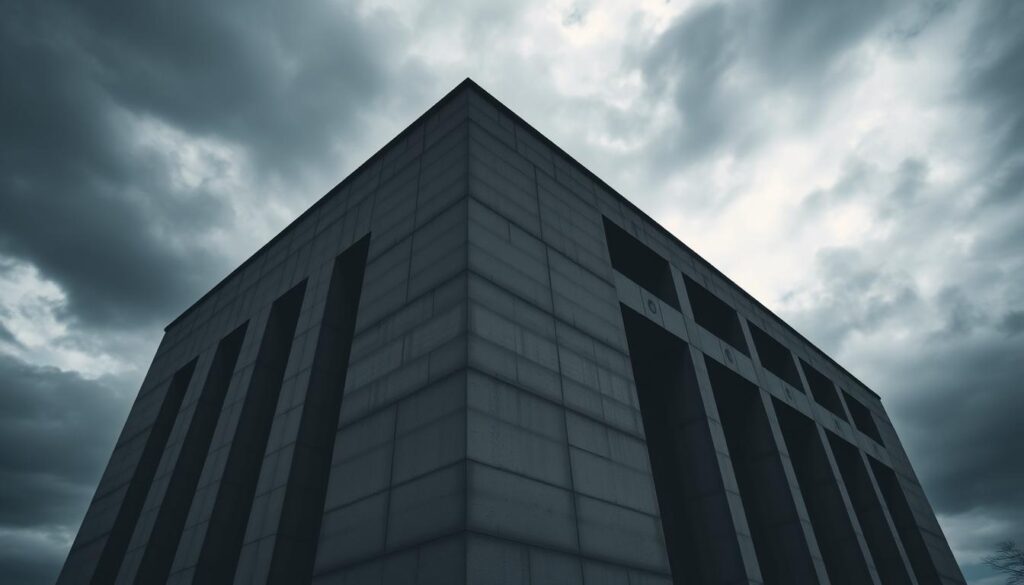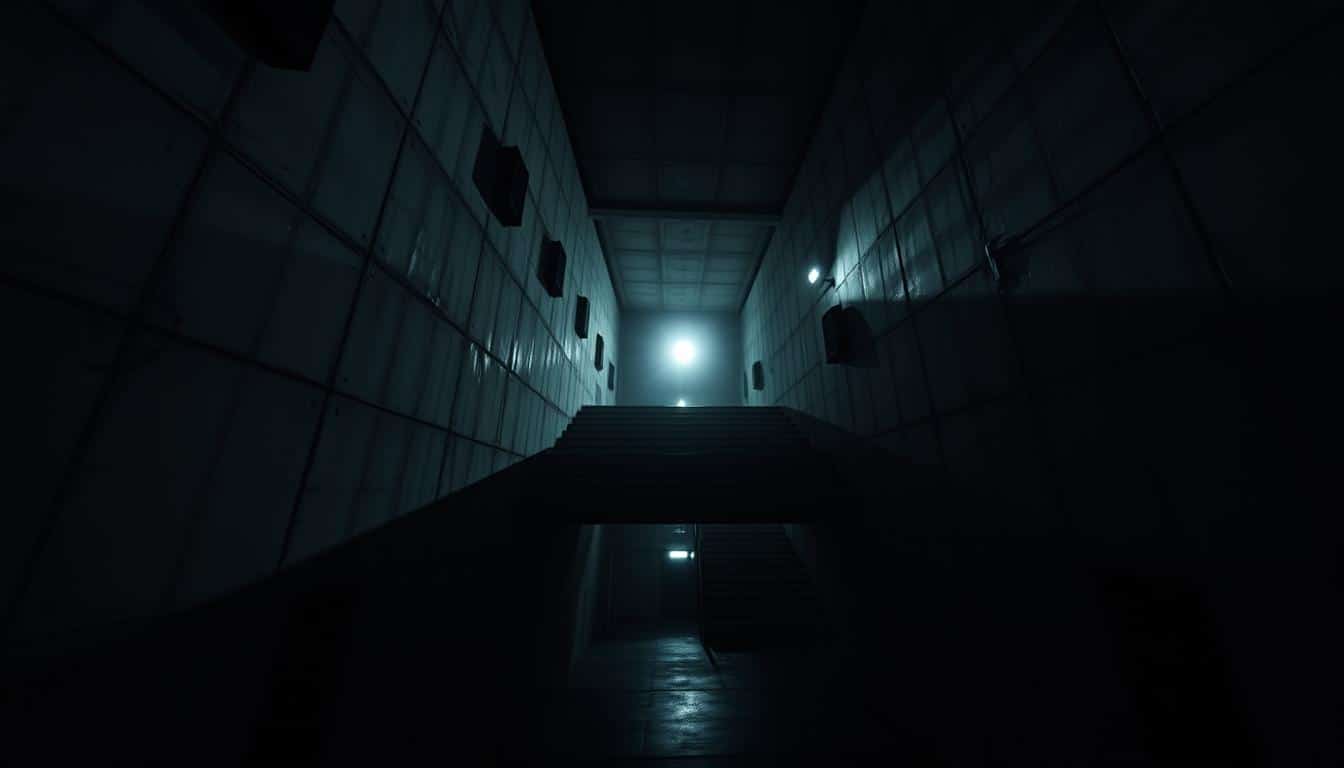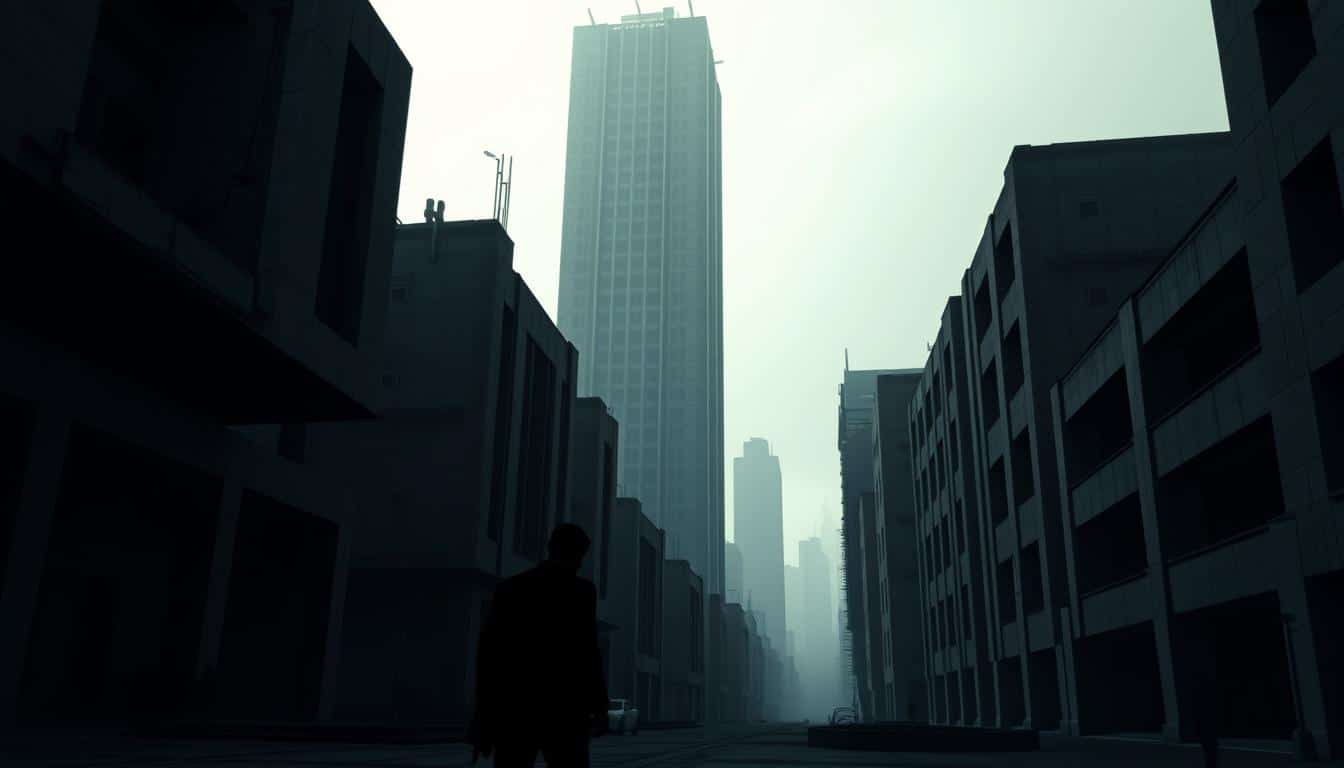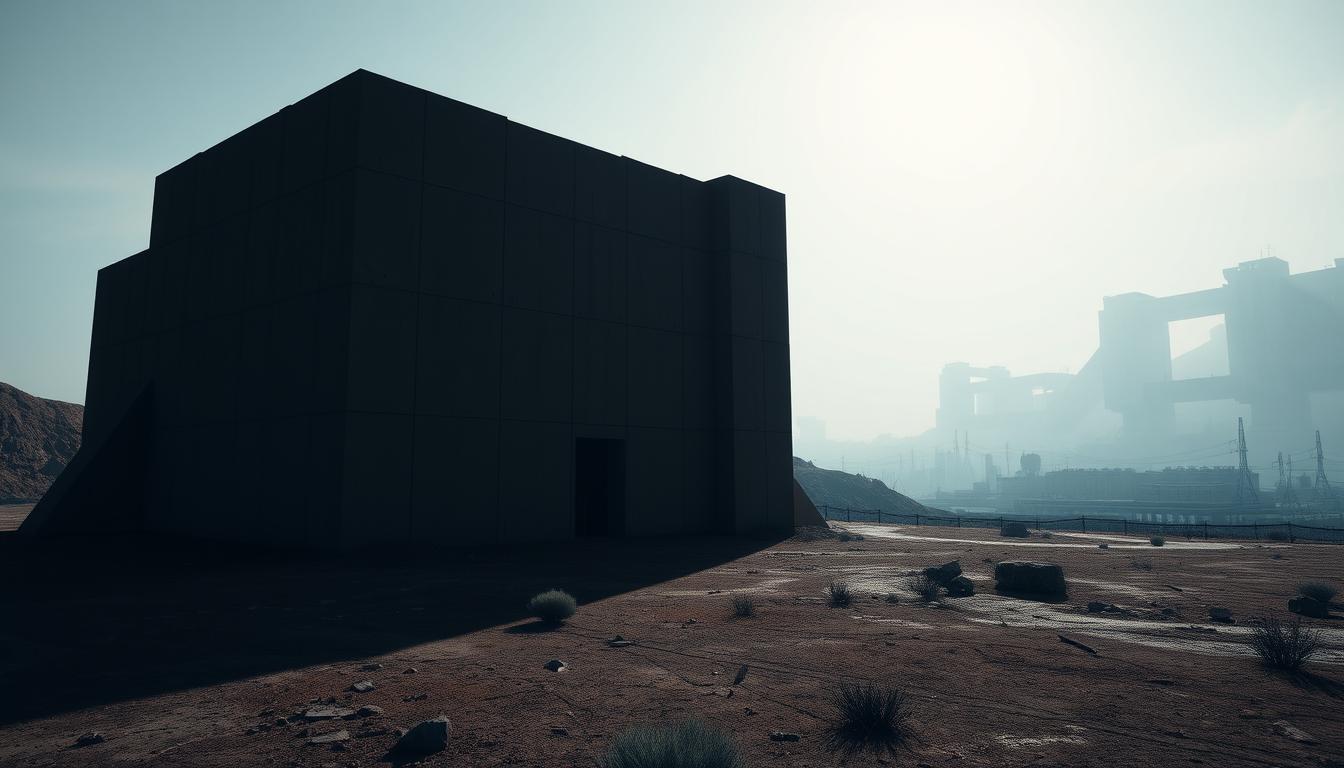Brutalist video games take players through stark, minimalist settings. These settings are paired with eerie sounds. This combo creates immersive worlds that deeply affect players. Brutalist styles in games have become more popular. They blend well with horror and loneliness themes. These design choices make gaming a trip through spooky places.
Understanding Brutalism: An Architectural Movement
Brutalism started making waves in the late 1940s. It’s known for its bold concrete look and distinctive shapes. The term “New Brutalism,” comes from “béton brut” in French, meaning raw concrete. This style focuses on being functional and simple, without fancy decorations. At first, it was a cheap way to rebuild cities after the war, offering a clear and strong look.
Architects like Le Corbusier were key in making brutalism popular. They crafted its rules, turning it into a major type of modern architecture. Brutalist buildings stand out, showing strength and making a statement in any place. What began as a practical solution is now a big cultural icon. It even affects areas like video game design today.

The Aesthetic Appeal of Brutalist Structures in Gaming
Brutalist design has a special place in gaming architecture. It turns virtual spaces into engaging digital realms. Its focus on bare forms and simplicity creates places that catch the eye and touch the heart. Gamers are drawn to the big sizes and simple beauty of these structures, creating a unique bond with their gameplay.
More and more, game makers are using brutalist ideas. They use materials like concrete and steel to make immersive settings. These choices bring out deep feelings in the games, like intensity and a sense of doom. The settings become a key part of exploring the game’s stories.
The importance of brutalist design in gaming keeps growing. Its cutting-edge look not only breaks old rules but also adds to the gamer’s adventure. With its focus on simplicity, power, and use, brutalism speaks a strong visual language that makes gaming better.
Defining Eerie Atmospheres in Brutalist-Inspired Video Games
Eerie atmospheres add a haunting feel to brutalist video games, changing how the game feels. The bold architecture and spooky sights and sounds make the game world intriguing. This setting draws players into exciting and eerie adventures, making the journey unforgettable.
The Role of Atmosphere in Gameplay Experience
The setting greatly shapes how players see and interact with the game. In games with brutalist designs, the stark concrete makes you feel alone and scared. This makes the game more emotionally gripping. Players move through spaces that feel new yet oddly familiar, making each moment in the game more intense.
How Sound Design Enhances Eeriness
Sound design is key in making these atmospheres feel eerie. Creepy sounds and background noises boost the visual part of the game. Sounds like weird echoes and soft whispers make the game more intense. This mix of sound and game settings makes the experience even more absorbing for players.
Notable Examples of Brutalist-Inspired Video Games
Brutalist aesthetics have shaped some video games in interesting ways. They make these games stand out. Players find unique experiences in them, thanks to distinct architectural styles and atmospheres.
NaissanceE: A Journey Through Concrete Landscapes
NaissanceE finds its muse in Tsutomu Nihei’s creations. It takes players through huge brutalist worlds. These places are filled with simple yet imposing shapes and massive structures.
Exploring becomes more than just moving around. It’s a deep dive into a world where every visual and sound means something. This game is not just about what you see and hear. It’s about feeling lost and finding your way in a maze of concrete.
Control: Exploring an Architectural Enigma
In Control, you get to explore the Oldest House, a mysterious brutalist skyscraper. This building is more than just a setting; it’s part of the story. It changes and moves, adding to the game’s strange feel.
It mixes stories of power with mystical forces. Plus, its odd architecture makes it unforgettable. It’s a game where the setting plays a big part in the story.
Mirror’s Edge: Parkour in Brutalist Environments
Mirror’s Edge uses brutalism in a futuristic way. Its world is sleek yet simple. Here, players run, jump, and navigate through a city that looks cool but has a deep story.
The game lets you interact a lot with the city. This makes its brutalist setting more than just a backdrop. It’s a big part of the action and story.
Industry Trends: The Resurgence of Brutalism in Video Games
The comeback of brutalism in video games is a big deal. It shows a changing trend in the gaming world that matches a bigger cultural shift. Game makers now lean towards designs that are simple yet deep in meaning. They want games to look raw and speak about themes like being alone and feeling scared.
Gamers are now drawn to the strange beauty of brutalist settings. These places are full of concrete and have a story to tell. They make players think about life and stir up deep feelings.
Many new games show how popular brutalism is becoming. They use brutalist architecture to make worlds that suck players in. This mix of old-style design with video games is pushing creativity to new heights. It makes gaming experiences that stick with you.
Eerie Atmospheres in Brutalist-Inspired Video Games
Brutalist-inspired video games are great at creating spooky vibes that really impact players. The tough look and feel of brutalist places make everything feel creepy. This pulls players into stories that are both cool and a bit scary. Every space and corner, with its plain concrete, makes you feel alone. This adds to the fun and tells a story filled with tension.
Putting together wide areas and tight spots makes players face their fears. The dull colors and simple style touch players’ feelings, making the game more than just play. It becomes a trip through your own mind.
The game’s sounds make everything feel more real. Echoes and quiet moments make the spooky feeling even stronger. As players move through these spaces, they start to wonder about their surroundings. This careful mix of sounds and places makes the scary feeling in these games really strong.
The Psychological Impact of Brutalist Aesthetics
The connection between brutalist aesthetics and how it affects players is truly special. The simple yet bold features of these environments make players feel alone, scared, and thoughtful. Such designs lead players to think deeply about their feelings and who they are.
Creating a Sense of Isolation and Dread
Brutalist structures are known for making players feel by themselves, making the game feel more intense emotionally. When moving through these areas, players might notice how alone they feel. This setting makes them feel very small, causing a deep sense of fear.
- The vastness of brutalist architecture reinforces feelings of loneliness.
- Players may confront themes of identity and disconnection.
- These environments can serve as reflections of inner turmoil.
The Alien Functionality of Brutalist Designs
How brutalist aesthetics work can make players feel out of place. Buildings that seem too big or hard to understand can make players feel lost. This makes the game’s psychological effect stronger. Players’ feelings get more intense as they explore, dealing with how strange everything feels.
- Architectural elements may challenge players’ understanding and comfort.
- Visually jarring designs can amplify unease and anxiety.
- Disorienting layouts encourage deeper introspection throughout the gameplay.
Brutalism and Liminal Spaces: A Fascinating Connection
The study of brutalism and liminal spaces reveals a deep link. Brutalist buildings, with their raw look, mirror the transition found in liminal spaces. This mix causes feelings of discomfort and interest, making spaces seem both known and strange.
In video games, liminal spaces make brutalism’s impact stronger. They create settings that enhance players’ feelings. These areas make players think about life’s odd, yet common moments. This makes them connect more with the game’s story, turning the setting into a part of their emotional adventure.
While moving through these areas, gamers often feel lost and thoughtful. Brutalism’s bold structures add to this mood, creating a unique mix that grabs attention. This connection between brutalism and liminal spaces is a vast field for creativity. It urges both creators and players to dive into complex feelings.
Future Directions: Evolving Brutalist Concepts in Gaming
The gaming world changes all the time, with new ideas shaping its future. Developers are always finding new ways to be creative. Brutalism in video games is becoming really important in creating new gaming experiences. Every new tech development lets game worlds make players feel more emotions. This is because of the unique buildings and designs in these games.
Designers are taking brutalism’s distinct features and putting them into games. This means players can enjoy stories that are much deeper. Here are a few ways this can happen:
- Immersive environments that challenge traditional aesthetics.
- Innovative gameplay mechanics that utilize space in unexpected manners.
- Architectural narratives that resonate on both emotional and psychological levels.
These aspects are changing what gaming will be like in the future. Developers are using them to play with how we see and understand games. By embracing brutalism, games are getting new layers that make them more interesting.
Conclusion
Exploring brutalism in video games opens new paths for creating spooky settings. This style’s raw look enhances stories by making players feel strong emotions. It changes how stories in games unfold, whether through big concrete areas or detailed insides.
Game creators are using these themes more, making games more immersive and emotionally deep. When brutalism meets spooky vibes, it challenges how we see things. This deepens our connection to the game world. It’s important as games keep growing and trying new things creatively.
We’re excited to see how game designers will use brutalism and spooky moods to tell stories differently. As these ideas become more popular, they’ll keep blending architecture with games. This blend will bring new, exciting stories to a wide audience. We can’t wait for what’s next in gaming.



